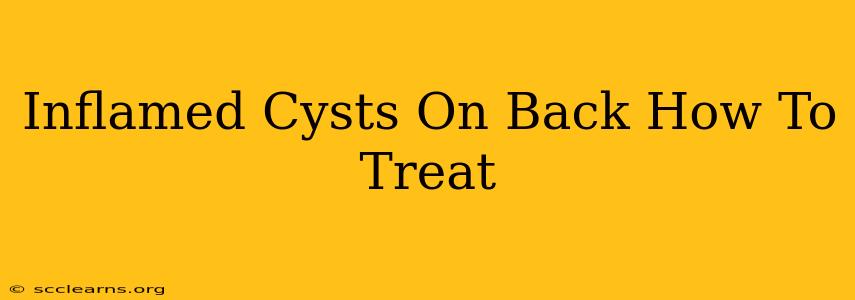Dealing with inflamed cysts on your back can be incredibly uncomfortable and frustrating. These bumps, often filled with fluid or semisolid material, can range from small and barely noticeable to large and painfully swollen. This comprehensive guide will explore the causes, treatment options, and prevention strategies for inflamed back cysts.
Understanding Inflamed Back Cysts
Before diving into treatment, it's crucial to understand what causes these unwelcome guests on your back. Several factors contribute to cyst formation and inflammation:
Common Causes:
- Blocked Hair Follicles (Pilonidal Cysts): These are frequently found in the cleft of the buttocks and are often caused by ingrown hairs. Infection can lead to inflammation and significant pain.
- Sebaceous Cysts: These develop from blocked oil glands and are generally benign. However, inflammation occurs when they become infected.
- Epidermoid Cysts: Similar to sebaceous cysts, these arise from trapped skin cells and can become inflamed.
- Infections: Bacteria can enter a cyst, causing infection, swelling, redness, and significant pain.
- Trauma: Injury to the skin can sometimes trigger cyst formation.
Treating Inflamed Cysts on Your Back
The treatment for an inflamed cyst depends on its size, location, and severity of inflammation. Always consult a dermatologist or healthcare professional for proper diagnosis and treatment. Self-treating can worsen the condition.
At-Home Care (For Minor Inflammation):
- Warm Compresses: Applying warm compresses several times a day can help reduce pain and swelling.
- Topical Antiseptics: A gentle antiseptic wash can help prevent infection. Follow product instructions carefully.
- Over-the-Counter Pain Relievers: Ibuprofen or acetaminophen can help manage pain.
Medical Treatments (For Severe Inflammation or Infection):
- Incision and Drainage: A doctor may need to make a small incision to drain the cyst's contents. This is often followed by antibiotic treatment.
- Antibiotics: If infection is present, antibiotics are crucial to combat the bacteria.
- Surgical Excision: For recurring cysts or large cysts that don't respond to other treatments, surgical removal may be necessary. This is a more invasive procedure but often provides a permanent solution.
Preventing Inflamed Back Cysts
While you can't always prevent cyst formation, you can reduce your risk by:
- Maintaining Good Hygiene: Regular showering and cleansing can help prevent blocked pores.
- Gentle Exfoliation: Regular exfoliation can help prevent ingrown hairs, a common cause of pilonidal cysts.
- Avoiding Tight Clothing: Tight clothing can trap sweat and increase the risk of blocked pores.
- Prompt Treatment of Ingrown Hairs: Address ingrown hairs promptly to prevent infection and cyst formation.
When to See a Doctor
Seek medical attention immediately if:
- The cyst is extremely painful.
- The cyst is rapidly increasing in size.
- You notice signs of infection, such as redness, warmth, pus, or fever.
- You have concerns about the cyst's appearance or nature.
Disclaimer: This information is for general knowledge and informational purposes only, and does not constitute medical advice. It is essential to consult with a qualified healthcare professional for any health concerns or before making any decisions related to your health or treatment. Self-treating can be dangerous, and professional medical advice is always recommended.

